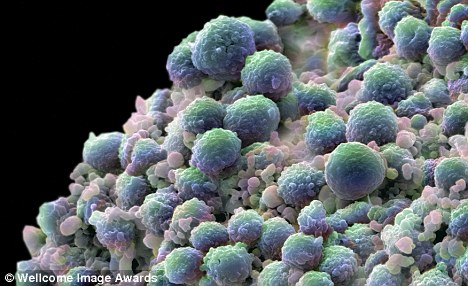
Scientists have unlocked the genetic secrets of prostate tumours in a breakthrough that could transform the treatment of the disease.
It raises the possibility of patients having their own ‘mutation charts’, mapping the precise flaws behind their illness and indicating the best drugs to treat them.
Dr Mike Berger, the U.S. study’s lead author, said: ‘This is a transforming moment in understanding the underlying biology of prostate cancer.’
Harvard Medical School researchers decoded the entire DNA of cancerous prostate tumours found in seven patients, before comparing the genetic sequences with those in healthy tissue, to pinpoint the defects behind the cancer.
Each tumour contained up to 5,900 small ‘spelling mistakes’ in its DNA. While this may seem a lot, it is far fewer than lung or skin cancer.
Of much more interest to the scientists was the finding that whole ‘paragraphs’ of DNA sequence were in the wrong order.
Analysis of these ‘rearrangements’ revealed genes tied to the formation and growth of the disease. Drugs that target some of these genes are already in development and could offer new hope for prostate cancer patients.
The study, reported in the journal Nature, is the first to lay bare the full genetic blueprint, or genome, of prostate cancer. Previous studies have focused on specific areas.

Dr Levi Garraway, one of the study’s authors, said it provided ‘fascinating new insights’.
He added: ‘This first whole genome view shows us tantalising evidence for several new prostate cancer genes that likely would have remained undiscovered.
‘Many of these features were invisible before. Now, we’re realising that by sequencing whole genomes in prostate cancer, there is a lot more to see.
‘These discoveries are teaching us a great deal about prostate cancer biology that we simply hadn’t appreciated previously.’
The researchers’ findings may also provide the basis for new tests for prostate cancer.
Currently, when patients are diagnosed, it is almost impossible for doctors to determine if the disease will advance quickly and therefore require aggressive treatment, or whether the tumours will remain slow-growing, necessitating a wait-and-see approach.
This leads to many men being subjected to unnecessary surgery and radiotherapy.
RELATED ARTICLES
- Britain's King Charles diagnosed with cancer
- USA Authorities Abduct 3yo Child, sentence him to Execution for curing Cancer at home
- Mysterious enriched uranium particle detected in skies over Alaska
- Have No Fear, Cancer Treatment is Finally Here!
- Pharma firm hikes life-saving drug price by 5500%











